
Keeping your cat at a healthy weight is important for their wellbeing. But sometimes it is difficult to tell what that ideal weight should be. Discover an easy, step-by-step tool to check your cat’s current and ideal size.
Cats come in all shapes and sizes so it’s sometimes tricky to determine whether yours is the right weight or not – after all, you love them regardless of any extra kilograms! But size does matter when it comes to health, and excess weight on your cat can cause problems. So, what is a healthy cat weight?
What is the average cat weight?
The ideal cat weight varies from breed to breed. According to WebMD, the average cat weight is about 4.5 kilograms, but while smaller breeds can be happy and healthy while weighting as little as 2 kilograms, larger breeds such as the Maine Coon can be 9 kilograms and happy.
This is where cat weight charts and body condition tools come in handy for checking the healthy cat weight for your pet.
Why is keeping a healthy weight for a cat important?
A healthy cat is a happy cat, and one much less prone to illness and health problems. If your cat is overweight, they may not live as long as their healthy counterparts, and they’ll be less able to enjoy themselves when they’re exercising and playing, because of potential joint problems.
Some specific concerns that can develop from excess weight include:
- Arthritis, joint damage and joint pain.
- Type 2 diabetes.
- Heart disease.
- Reduced exercise endurance and stamina.
- Increased anaesthetic and surgical risks.
- Reduced liver function due to a fatty liver.
What is a cat body condition tool?
We try to avoid putting the emphasis on weight, because there’s more to having a healthy cat than weight alone.
Created by pet care experts, our Body Condition Tool is designed to help you determine if your cat is a healthy size overall, and encourages you to get hands on with your cat, to get to know their actual size underneath all that fur!
How to use our body condition tool for checking the ideal cat weight
You should look at your cat from every angle to get an all-round view – this is important in finding a healthy weight for a cat. Take your time and be gentle – your cat might not be used to being handled like this, but they’ll soon get used to it.
Example of body condition scoring for the healthy cat weight
Remember, weight alone won’t tell you if your pet is the right size. To find out your cat’s body condition score, you’ll need to get hands on!
Not sure if you’re judging it properly? The ideal healthy cat weight is leaner than you might think, mainly because pet owners tend to underestimate the weight of their cats. Each individual cat will require different food, a different meal size and varying levels of cat exercise. Depending on their body shape, size and breed, it’s quite possible that two cats could weigh exactly the same, but one would be overweight and the other would be underweight!
Take a look at these examples of cats that have been scored against the Body Condition Tool. There’s a lot of variety here – it’s not just about weight, but about the size and shape, too.
Purina Body Condition Tool
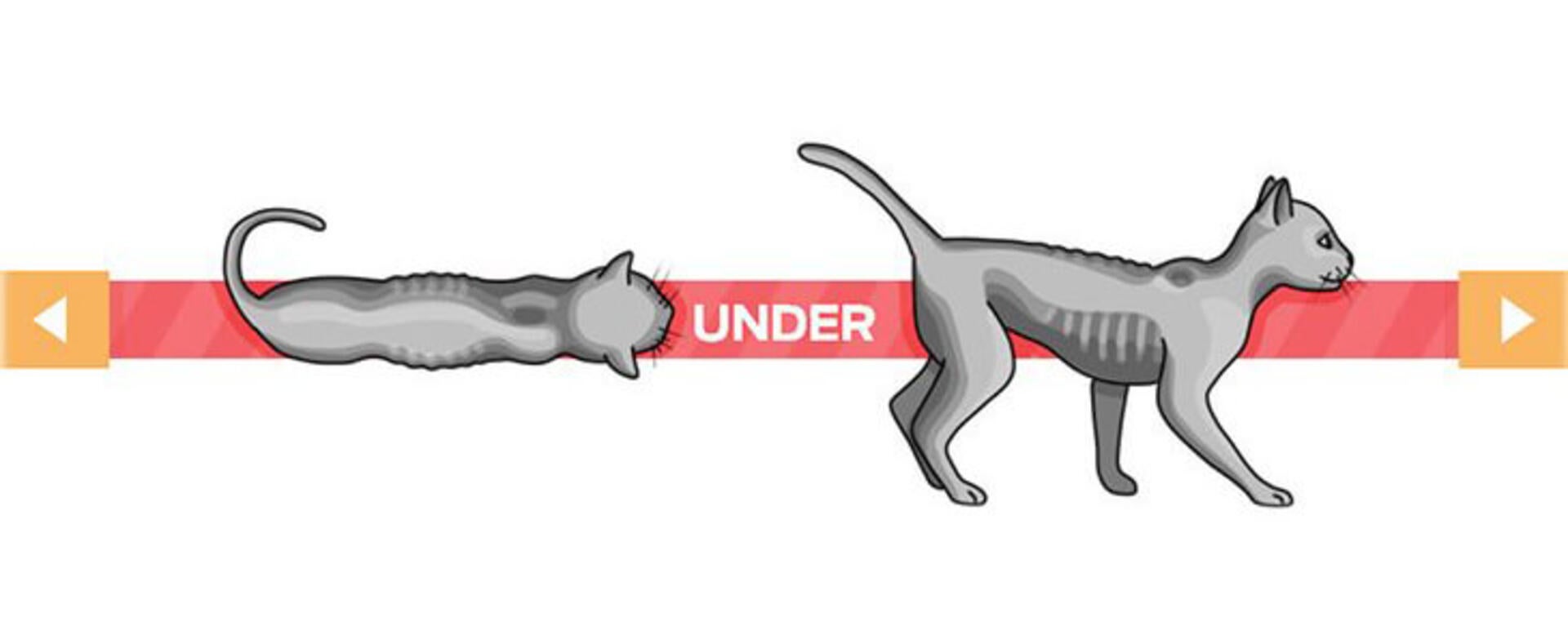
Your Cat's Condition
Severely Underweight
- Ribs, backbone and hip bones all highly visible with complete absence of any fat.
- Severely exaggerated waistline.
- Tummy non-existent.
Very Thin
- Ribs and backbone easily seen with no overlying fat layer.
- Exaggerated waistline.
- Severe tummy tuck.
- If your cat is not in ideal body condition, we recommend you seek veterinary advice to ensure there is not underlying medical cause for weight loss or gain.
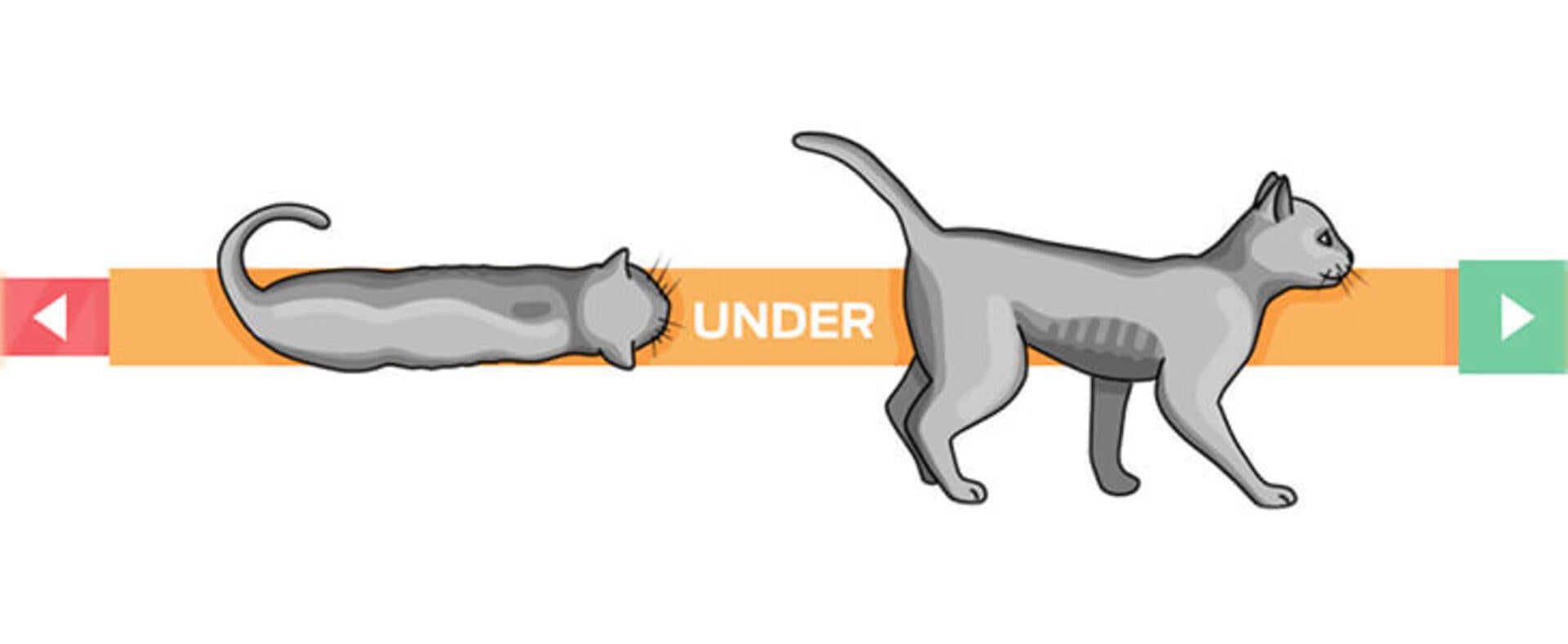
Your Cat's Condition
Thin
- Ribs, backbone are easily felt and seen with minimal overlying fat layer.
- Noticeable waistline.
- Distinct tummy tuck with no belly fat.
Slightly Underweight
- Ribs can be felt and may/may not be seen with very thin layer of overlying fat.
- Obvious waistline.
- Slight tummy tuck with minimal belly fat.
- If your cat is not in ideal body condition, we recommend you seek veterinary advice to ensure there is not underlying medical cause for weight loss or gain.
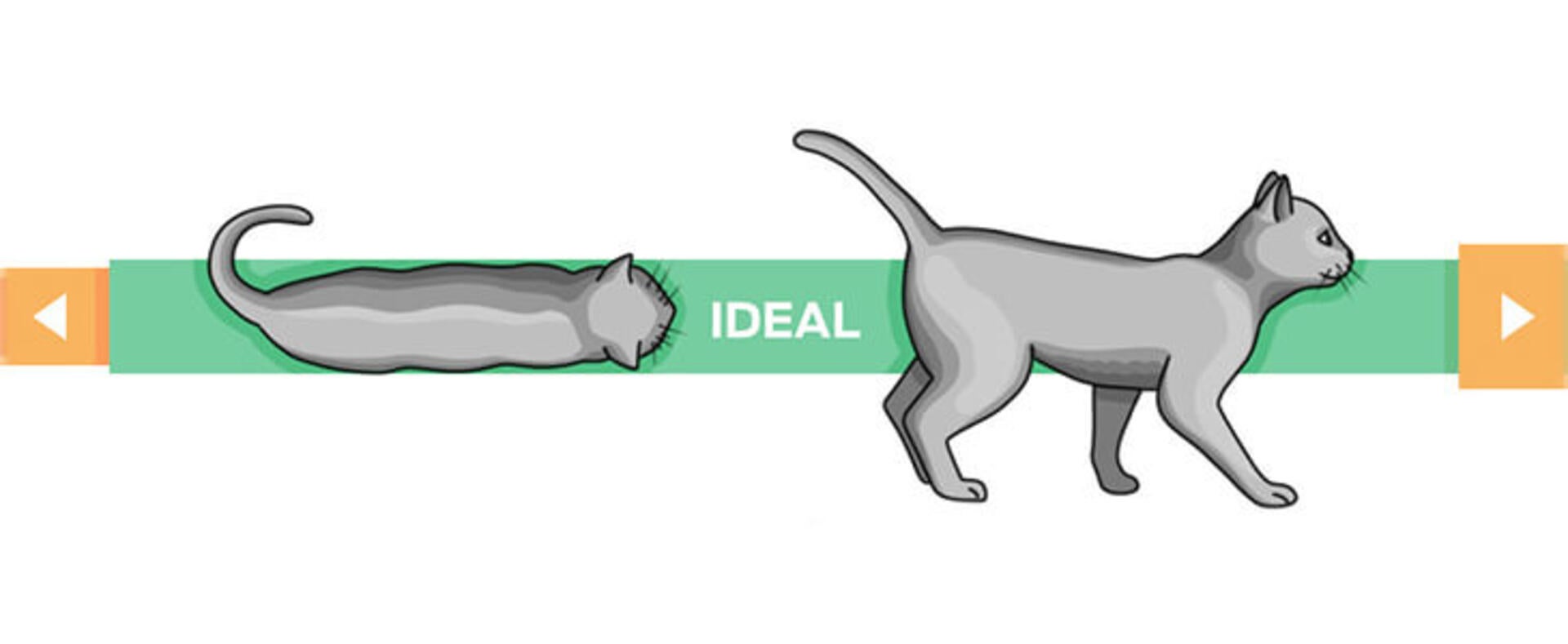
Your Cat's Condition
Ideal Weight
- Ribs can be felt and may/may not be seen with a small layer of overlying fat.
- A clear waistline can be seen.
- Visible tummy tuck.
- If your cat is not in ideal body condition, we recommend you seek veterinary advice to ensure there is not underlying medical cause for weight loss or gain.
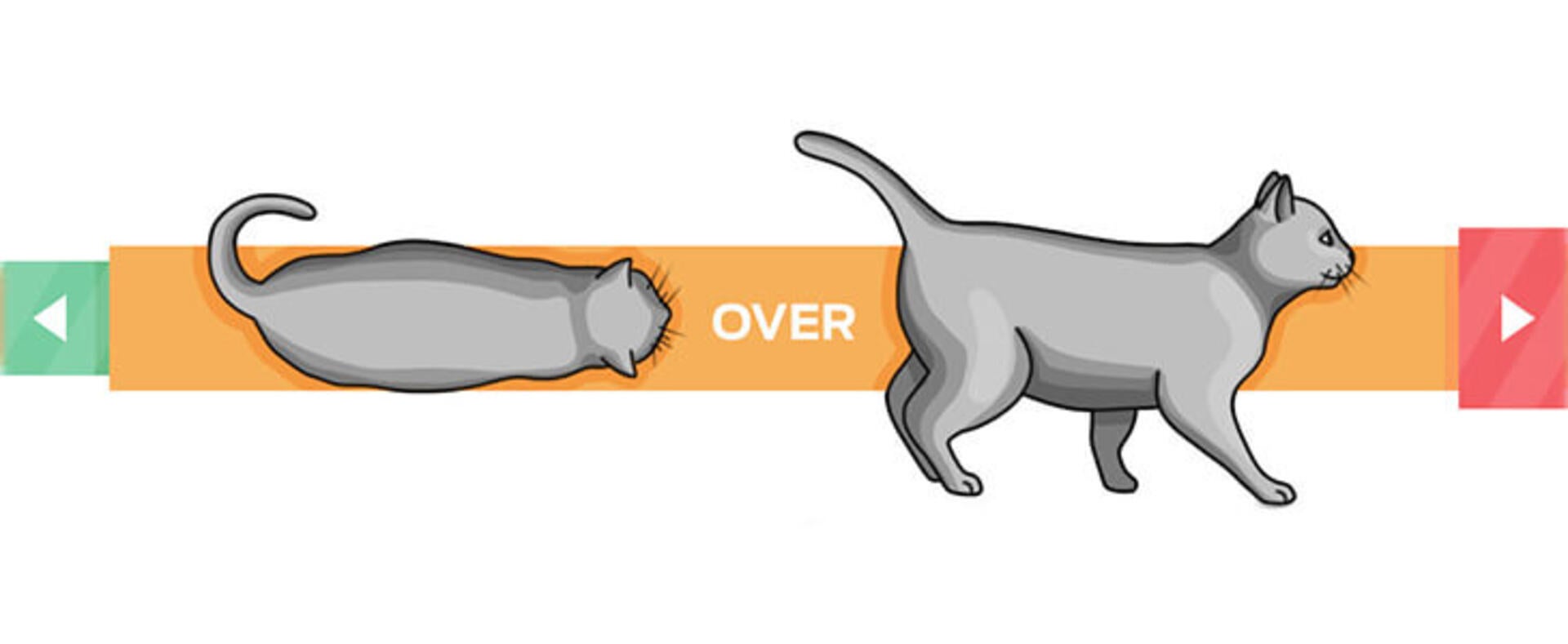
Your Cat's Condition
Overweight
- Ribs can be felt, but generally can't be seen, with a distinct layer of overlaying fat.
- Waistline is not clear.
- Tummy may bulge slightly outwards and sag downwards, with a small fat pad.
Very Overweight
- Ribs are hard to feel and see with a thickened layer of overlying fat.
- Waistline is difficult to see.
- Tummy bulges outwards and may sag downwards with noticeable fat pad that may wobble when cat moves.
- If your cat is not in ideal body condition, we recommend you seek veterinary advice to ensure there is not underlying medical cause for weight loss or gain.
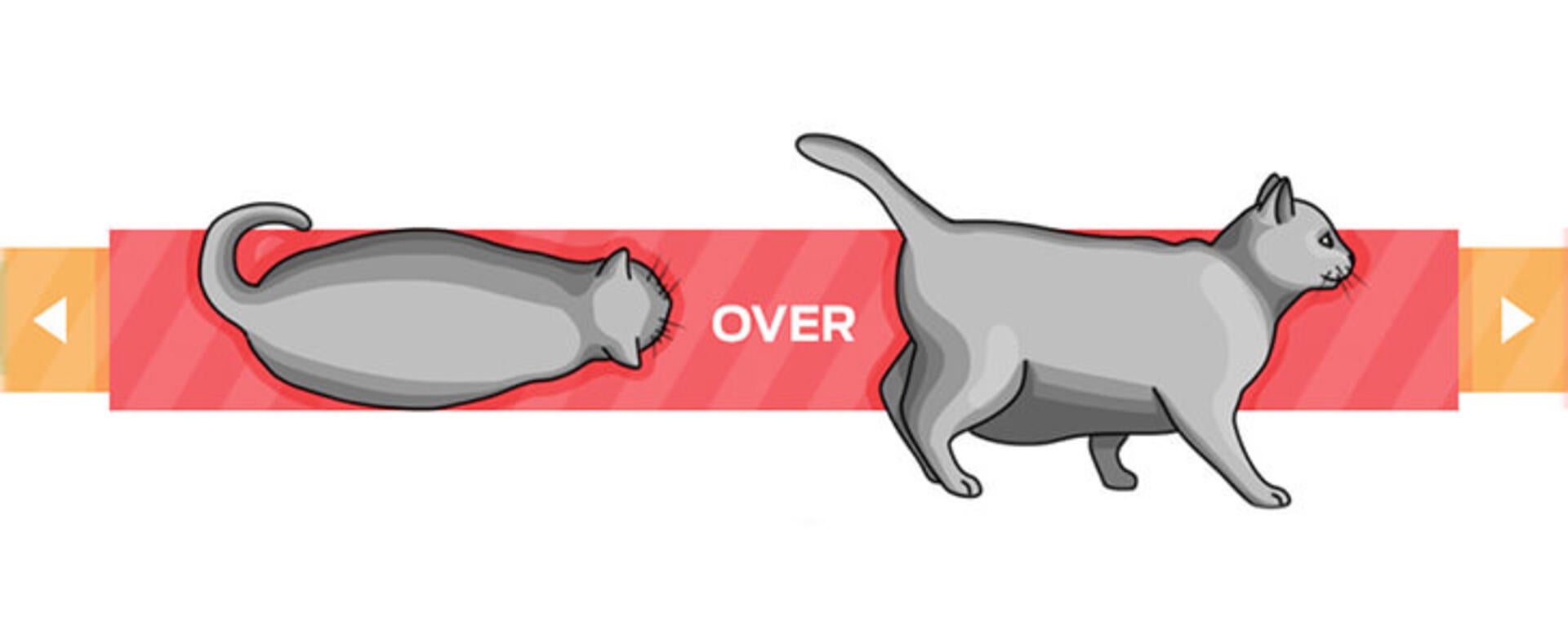
Your Cat's Condition
Obese
- Ribs can't be felt or seen with a very thick layer of overlying fat.
- Additional fat pads present over the lower back.
- Waistline is absent.
- Tummy bulges outwards and may sag downwards with obvious fat pad that probably wobbles or sways when cat moves.
Clinically Obese
- Ribs are impossible to feel with a marked layer of very thick overlying fat.
- Additional heavy fat pads are noticeable over the lower back, legs and around the face.
- Waistline is absent.
- Tummy distinctly bulges and sags downwards, with a substantial fat pad that wobbles or sways when your cat moves.
- If your cat is not in ideal body condition, we recommend you seek veterinary advice to ensure there is not underlying medical cause for weight loss or gain.
What to do if your cat is above the ideal cat weight?
Overweight cats can be encouraged to lose weight by feeding them a balanced diet and keeping your cat active through play. In some cases reducing the cat treats they get alongside the main meals might be enough to get them back to an average weight.
Make sure you ask for your vet’s advice before making any drastic changes to your cat’s diet. The vet will also be able to recommend a weight management plan that will keep your cat at a healthy weight.
What to do if your cat is below the average cat weight?
If the body condition tool revealed that your cat is underweight, discuss with your vet the best way to add extra calories to the diet in a healthy and beneficial way. Although it is tempting to go for the cat treats bag to help your pet gain the extra kilograms they need, make sure they’re also getting the right balance of nutrients at the same time.
Even if your cat is on the thin side, don’t be tempted to cut off play time. Exercise is important for cats below the average weight as well. It can help build muscle and might even increase their appetite.
In this case as well it is important to check with your vet for healthy ways to help your cat gain weight, but also to make sure there aren’t any underlying conditions stopping your cat from reaching that healthy weight.






